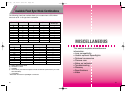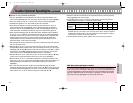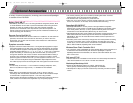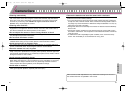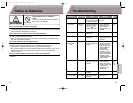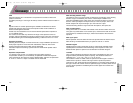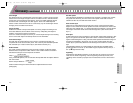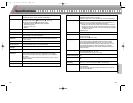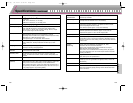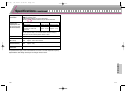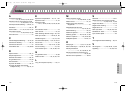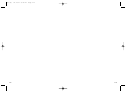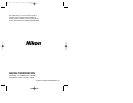
103102
MISCELLANEOUS
Glossary
CPU
Central Processing Unit. The electronic component that controls an electronic
product’s functions.
AF Nikkor (including D- and G-type AF Nikkor) and AI-P-Nikkor lenses have built-in
CPUs.
EV
Exposure Value: A number representing the available combinations of shutter
speeds and apertures that give the same exposure effect under conditions of
similar scene brightness and ISO.
At ISO 100, the combination of a one-second shutter speed and an aperture of
f/1.4 is defined as EV1.
The camera can be used only within the EV range of the exposure meter. For
example, with the F65/F65D, the exposure metering range is from EV1 to EV20 for
3D Matrix Metering and Centre-Weighted Metering, at ISO 100 with an f/1.4 lens.
Exposure bracketing
Shooting the same subject a number of times at a range of different exposures to
attain proper exposure. Three shots with metered EV, under EV, and over EV
exposure are performed in that order with the F65/F65D.
Automatic exposure bracketing is performed with varied shutter speeds and/or
apertures.
Exposure Compensation
In a situation such as when your subject is strongly backlit, exposure
compensation enables you to intentionally compensate the standard exposure
value measured by the camera to create a desired effect. exposure compensation
of –2 EV to +2 EV in 1/2 steps is available with the F65/F65D.
Flash shooting distance range
The distance range over which a flash can effectively provide light. Flash shooting
distance range is controlled by the amount of flash output available. Each
automatic Speedlight’s flash output varies from maximum duration to minimum
duration. Close-up subjects will require lower (to minimum) output, while more
distant subjects will require more light up to the maximum output.
The flash shooting distance range varies with the aperture, film speed, etc.
Flash synchronisation
Timing of the flash so it coincides with release of the camera’s shutter. There are
two types of synchronisation: Front-Curtain Sync, which fires the flash at the start
of the exposure, and Rear-Curtain Sync, which fires the flash at the end of the
exposure.
Flash sync speed
Shutter speed at which the entire film frame is exposed when the flash is fired in
flash shooting. The F65/F65D’s flash sync speed is 1/90 sec. or slower.
Flexible Program
Flexible Program function temporarily shifts an automatically selected shutter
speed/aperture combination while maintaining correct exposure. That is, the
desired shutter speed or aperture can be selected in Auto-Multi Program.
f-number
The f-number represents the aperture value and is calculated from lens’ focal
length divided by the effective aperture opening. The standard numbers for
calibration are 1, 1.4, 2, 2.8, 4, 5.6, 8, 11, 16, 22, 32, etc.
The smallest f-number is called maximum aperture and the largest f-number is
called minimum aperture. Lenses with large maximum apertures (smaller f-
numbers) are ‘fast’ lenses that allow photographers to use faster shutter speeds in
dim light. Lenses with smaller maximum apertures (larger f-numbers) allow the use
of lower shutter speeds for available light but are also lighter and smaller than
faster lenses.
F65 (E) 02.12.27 5:43 PM Page 102



